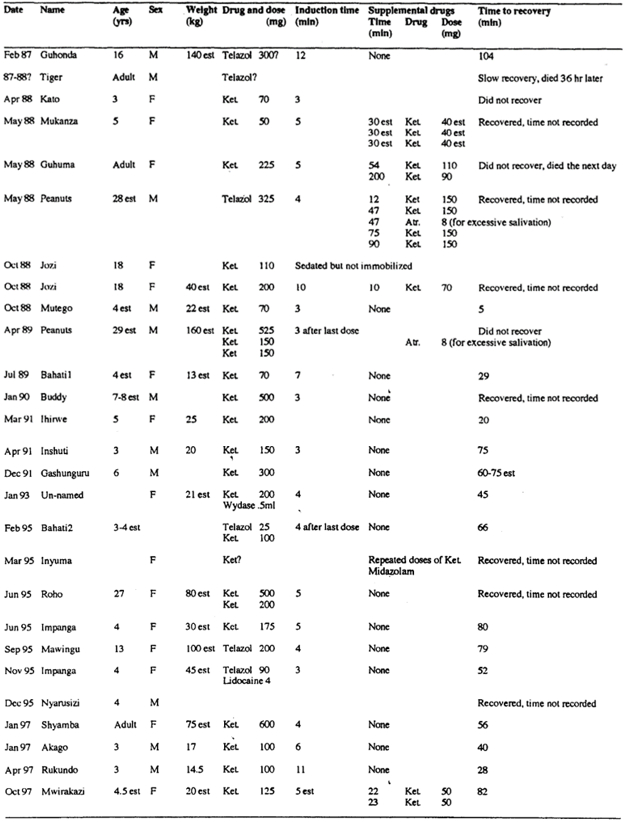1Veterinary Teaching Hospital, Colorado State University, Fort Collins, CO, USA; 2Mountain Gorilla Veterinary Center, Kigali, Rwanda; 3Tai, Ivory Coast; 4Wildlife Health Services, Wellingborough, UK; 5International Gorilla Conservation Programme, Kampala, Uganda; 6San Antonio, TX, USA
Abstract
The Morris Animal Foundation’s Mountain Gorilla Veterinary Center (formerly the Volcano Veterinary Center) was established in 1986. Since its inception, 26 field anesthesias of mountain gorillas have been performed for either life-threatening problems or severe human-induced disease. The majority of anesthesias (i.e., 18 of 26, or 69%) were performed to remove rope or wire snares from a limb, or to treat snare induced wounds.
Table 1 summarizes the anesthetic data available from each procedure. For animals with an actual recorded weight the mean induction dosage of ketamine was 7.1 mg/kg (range: 5.9–8.0 mg/kg; n=4), a dosage similar to those recommended for western lowland gorillas (Gorilla gorilla gorilla).1 The mean induction time for anesthesias requiring a single initial dose of ketamine was 5.2 min (range: 3–11 min; n=13). All induction agents were delivered by remote injection using the Telinject® system, and occasionally multiple darting attempts were necessary. Every attempt was made to dart the animal unawares and thus minimize disturbance to the gorillas. All interventions required a team approach with considerable cooperation from the researchers of the Dian Fossey Gorilla Fund’s Karisoke Research Center, the Mountain Gorilla Project and the International Gorilla Conservation Programme. Fundamental to the success of the interventions was the assistance of the park staff and gorilla trackers from the Office Rwandais pour le Tourisme et les Parc Nationaux, the Institut Congolais pour la Conservation de la Nature (formerly the Institut Zairois pour la Conservation de la Nature) and the Karisoke Research Center. In addition, porters were hired to carry the equipment within the forest.
Table 1. Summary of the anesthetic data from the immobilization of free-ranging mountain gorillas from the Virunga Volcano Region, Central Africa

Induction time=time from initial injection to recumbency
Supplemental drug administration time is listed as time from the initial injection
Time to recovery=time from initial injection to ambulation
M=male; F=female
est=estimate<ket.=ketamine; telazol="mixture" of="" tiletamine="" and="" zolazepam;="" atr.="atropine;" wydase="hyaluronidase<br">?=information may be inaccurate
Blank space indicates information missing or not recorded</ket.=ketamine;>
The procedures were performed within or in close proximity to the rest of the group of gorillas. Thus, once the animal was anesthetized, a team was assigned to keep the other gorillas away from the patient and create a visual barrier. Only one human injury (a bite wound) has occurred as a result of an anesthesia. More injuries were reported as a result of the physical restraint of gorillas. Occasionally there was moderate disruption to the group with some reaction from other gorillas, in particular, the silverback males but no long-term behavioral effects have been noted. No intraspecific aggression was noted during or immediately after the procedures. The intervention team would remain with the gorilla until it was fully recovered and able to rejoin its group. For gorillas given a single dose of ketamine the mean recovery time was 42 min (range: 5–80 min; n=9). Four animals did not recover from anesthesia due to the severe nature of their medical conditions. One animal was physically removed from the park and anesthetized at a local human hospital. This individual was not included in this study.
Literature Cited
1. Kreeger T J. 1996. Handbook of Wildlife Chemical Immobilization. International Wildlife Veterinary Services, Inc. Pp. 165.